steering MAZDA MODEL CX-5 2017 - RHD (UK, Australia) (in English) Owner's Guide
[x] Cancel search | Manufacturer: MAZDA, Model Year: 2017, Model line: MODEL CX-5, Model: MAZDA MODEL CX-5 2017Pages: 772, PDF Size: 19.35 MB
Page 243 of 772
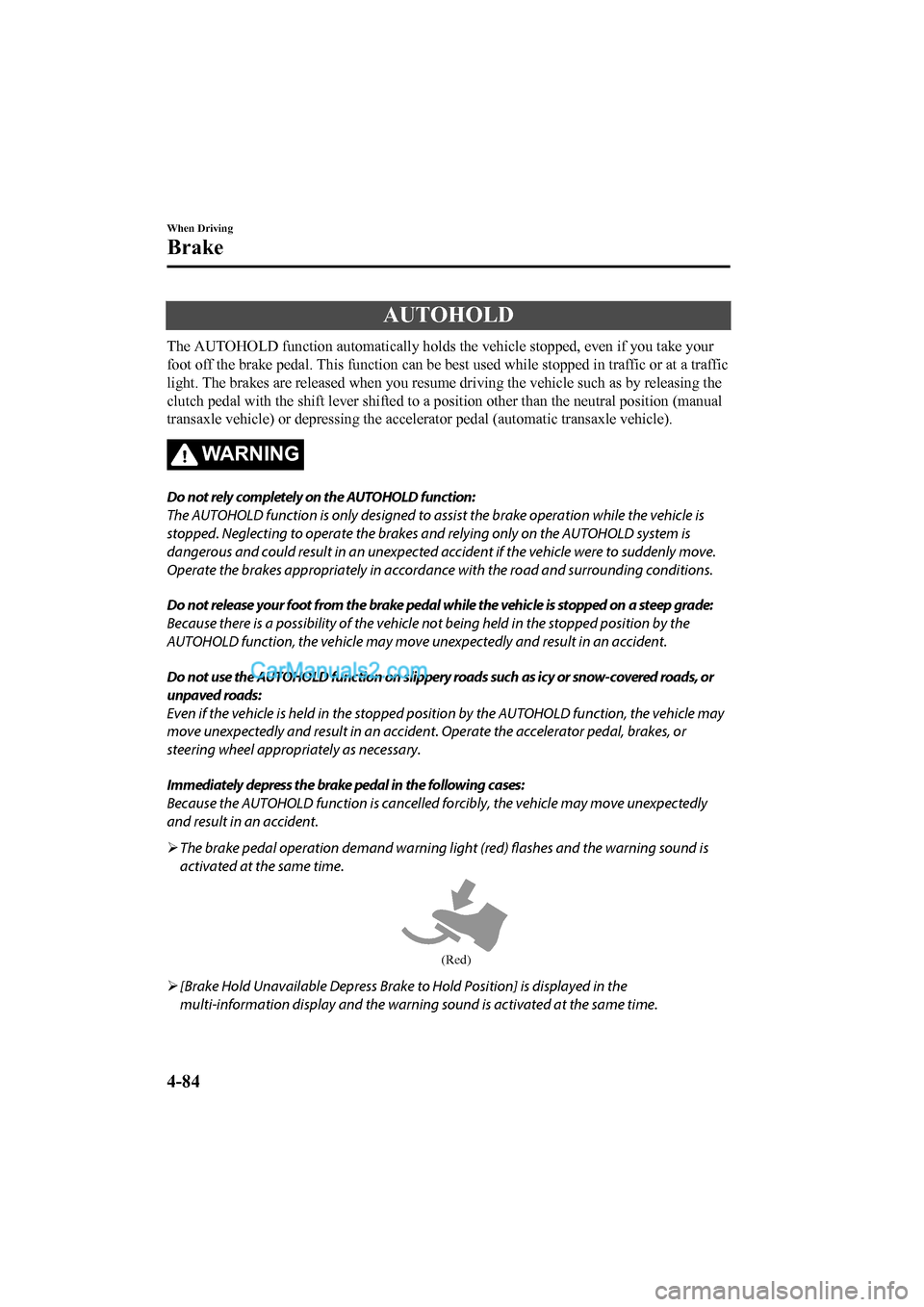
AUTOHOLD
The AUTOHOLD function automatically holds the vehicle stopped, even if you take your
foot off the brake pedal. This function can be best used while stopped in traffic or at a traffic
light. The brakes are released when you resume driving the vehi cle such as by releasing the
clutch pedal with the shift leve r shifted to a position other than the neutral position (manual
transaxle vehicle) or depressing the accelerator pedal (automat ic transaxle vehicle).
WA R N I N G
Do not rely completely on the AUTOHOLD function:
The AUTOHOLD function is only designed to assist the brake operation while the vehicle is
stopped. Neglecting to operate the brakes and relying only on the AUTOHOLD system is
dangerous and could result in an unexpected a ccident if the vehicle were to suddenly move.
Operate the brakes appropriatel y in accordance with the road and surrounding conditions.
Do not release your foot from the brake pedal while the vehicle is stopped on a steep grade:
Because there is a possibility of the vehicle not being held in the stopped position by the
AUTOHOLD function, the vehicle may move un expectedly and result in an accident.
Do not use the AUTOHOLD function on slippery roads such as icy or snow-covered roads, or
unpaved roads:
Even if the vehicle is held in the stopped posi tion by the AUTOHOLD function, the vehicle may
move unexpectedly and result in an accident . Operate the accelerator pedal, brakes, or
steering wheel approp riately as necessary.
Immediately depress the brake pedal in the following cases:
Because the AUTOHOLD function is cancelled forcibly, the vehicle may move unexpectedly
and result in an accident.
The brake pedal operation demand warning light (red) flashes and the warning sound is
activated at the same time.
(Red)
[Brake Hold Unavailable Depress Brake to Hold Position] is displayed in the
multi-information display and the warning sound is activated at the same time.
When Driving
Brake
4-84
2017-6-7 7:51:19 Form No. CX-5 8FY4-EE-17E+L_Edition2
Page 254 of 772
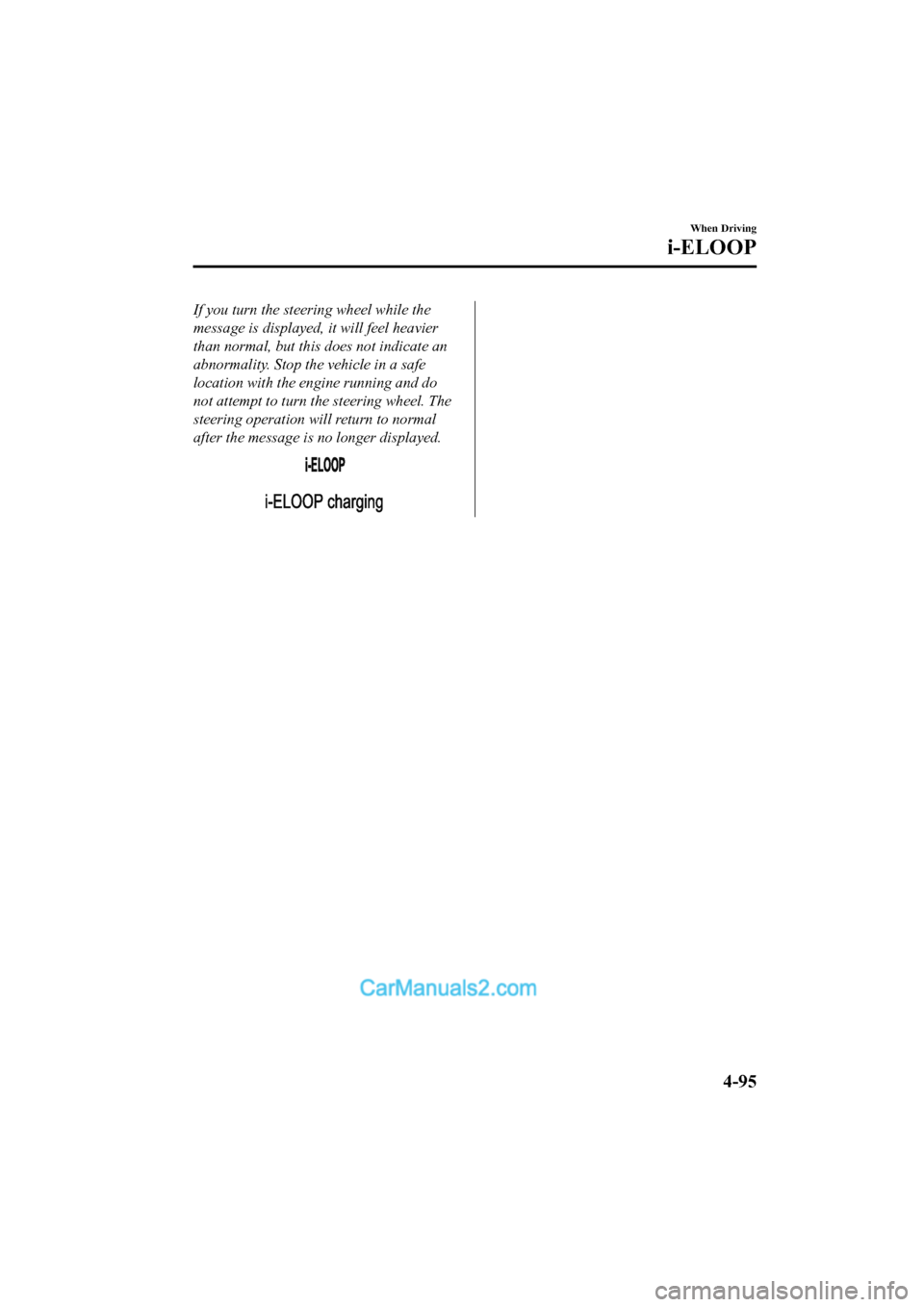
If you turn the steering wheel while the
message is displayed, it will feel heavier
than normal, but this does not indicate an
abnormality. Stop the vehicle in a safe
location with the engine running and do
not attempt to turn the steering wheel. The
steering operation will return to normal
after the message is no longer displayed.
When Driving
i-ELOOP
4-95
2017-6-7 7:51:19 Form No. CX-5 8FY4-EE-17E+L_Edition2
Page 260 of 772
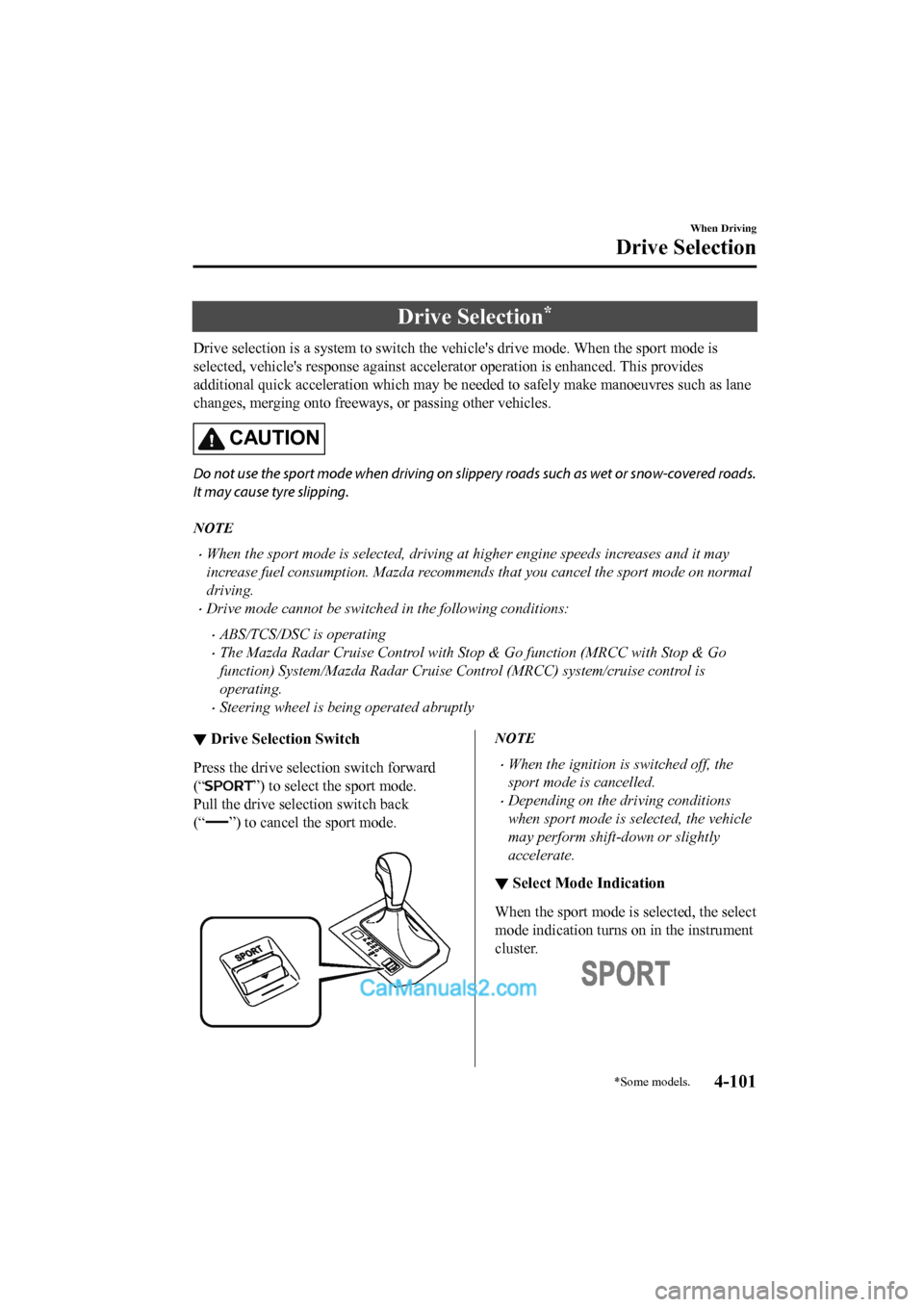
Drive Selection*
Drive selection is a system to switch the vehicle's drive mode. When the sport mode is
selected, vehicle's response against accelerator operation is enhanced. This provides
additional quick acceleration which may be needed to safely mak e manoeuvres such as lane
changes, merging onto freeways, or passing other vehicles.
CAUTION
Do not use the sport mode when driving on slip pery roads such as wet or snow-covered roads.
It may cause tyre slipping.
NOTE
•When the sport mode is selected, driving at higher engine speeds increases and it may
increase fuel consumption. Mazda recommends that you cancel the sport mode on normal
driving.
•Drive mode cannot be switched in the following conditions:
•ABS/TCS/DSC is operating
•The Mazda Radar Cruise Control with St op & Go function (MRCC with Stop & Go
function) System/Mazda Radar Cruise Control (MRCC) system/cruise control is
operating.
•Steering wheel is being operated abruptly
▼ Drive Selection Switch
Press the drive selection switch forward
(“
”) to select the sport mode.
Pull the drive selection switch back
(“
”) to cancel the sport mode.
NOTE
•When the ignition is switched off, the
sport mode is cancelled.
•Depending on the driving conditions
when sport mode is selected, the vehicle
may perform shift-down or slightly
accelerate.
▼ Select Mode Indication
When the sport mode is selected, the select
mode indication turns on in the instrument
cluster.
When Driving
Drive Selection
*Some models.4-101
2017-6-7 7:51:19 Form No. CX-5 8FY4-EE-17E+L_Edition2
Page 262 of 772
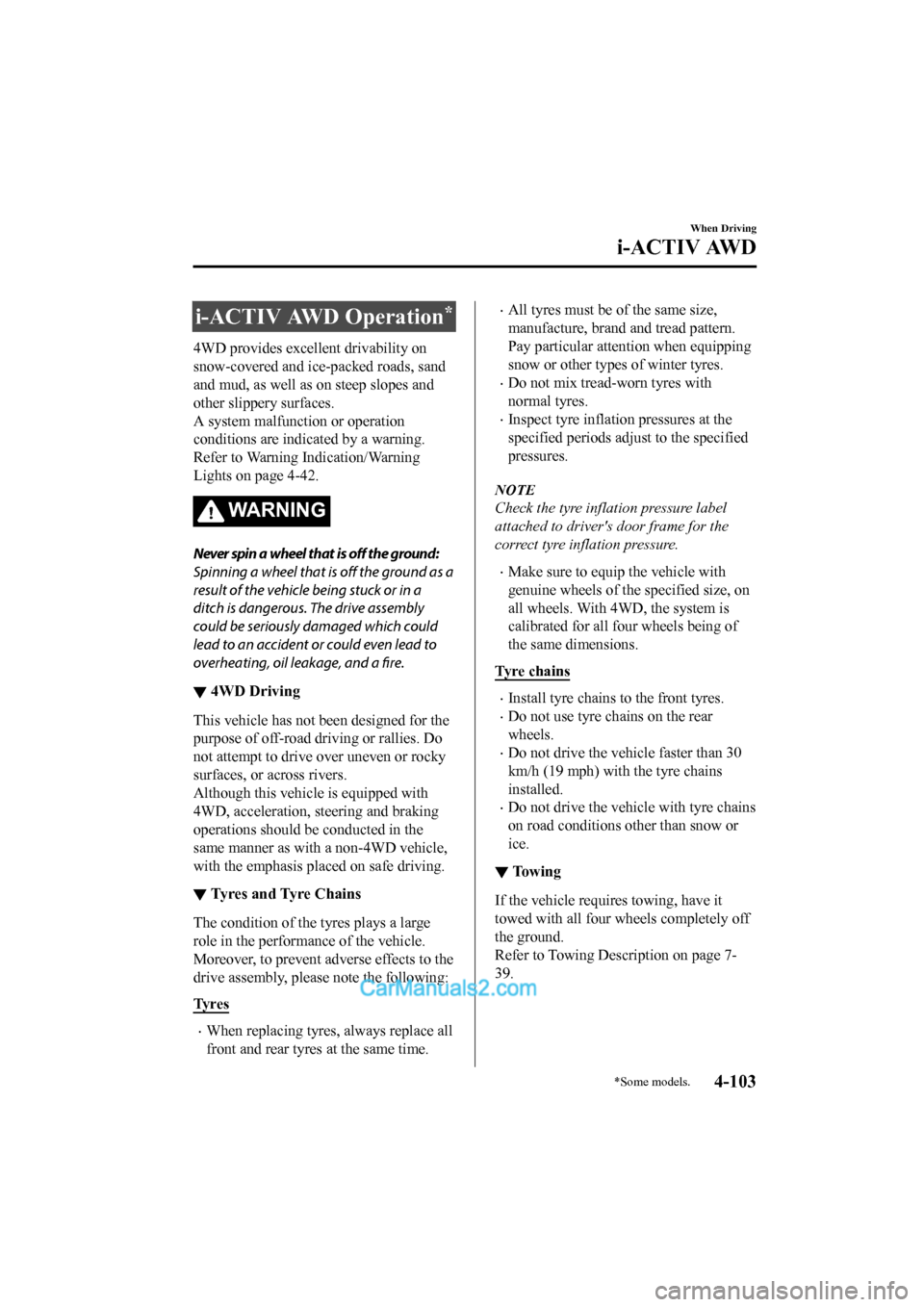
i-ACTIV AWD Operation*
4WD provides excellent drivability on
snow-covered and ice-packed roads, sand
and mud, as well as on steep slopes and
other slippery surfaces.
A system malfunction or operation
conditions are indicated by a warning.
Refer to Warning Indication/Warning
Lights on page 4-42.
WA R N I N G
Never spin a wheel that is off the ground:
Spinning a wheel that is off the ground as a
result of the vehicle being stuck or in a
ditch is dangerous. The drive assembly
could be seriously damaged which could
lead to an accident or could even lead to
overheating, oil leakage, and a fire.
▼ 4WD Driving
This vehicle has not been designed for the
purpose of off-road driving or rallies. Do
not attempt to drive over uneven or rocky
surfaces, or across rivers.
Although this vehicle is equipped with
4WD, acceleration, steering and braking
operations should be conducted in the
same manner as with a non-4WD vehicle,
with the emphasis placed on safe driving.
▼Tyres and Tyre Chains
The condition of the tyres plays a large
role in the performance of the vehicle.
Moreover, to prevent adverse effects to the
drive assembly, please note the following:
Ty r e s
•When replacing tyres, always replace all
front and rear tyres
at the same time.
•All tyres must be of the same size,
manufacture, brand and tread pattern.
Pay particular attention when equipping
snow or other types of winter tyres.
•Do not mix tread-worn tyres with
normal tyres.
•Inspect tyre inflation pressures at the
specified periods adjust to the specified
pressures.
NOTE
Check the tyre inflation pressure label
attached to driver's door frame for the
correct tyre inflation pressure.
•Make sure to equip the vehicle with
genuine wheels of the specified size, on
all wheels. With 4WD, the system is
calibrated for all four wheels being of
the same dimensions.
Ty r e c h a i n s
•Install tyre chains to the front tyres.
•Do not use tyre chains on the rear
wheels.
•Do not drive the vehicle faster than 30
km/h (19 mph) with the tyre chains
installed.
•Do not drive the vehicle with tyre chains
on road conditions other than snow or
ice.
▼ To w i n g
If the vehicle requires towing, have it
towed with all four wheels completely off
the ground.
Refer to Towing Description on page 7-
39.
When Driving
i-ACTIV AWD
*Some models.4-103
2017-6-7 7:51:19 Form No. CX-5 8FY4-EE-17E+L_Edition2
Page 263 of 772

Power Steering
•Power steering is only operable when
the engine is running. If the engine is off
or if the power steering system is
inoperable, you can still steer, but it
requires more physical effort.
If the steering feels stiffer than usual
during normal driving or the steering
vibrates, consult an expert repairer, we
recommend an Authorised Mazda
Repairer.
•The warning indication/warning light
notifies the driver of system
abnormalities and operation conditions.
In addition, the buzzer may also activate
depending on the system abnormality or
operation condition.
Refer to Warning Indication/Warning
Lights on page 4-42.
Refer to Power Steering Warning
Buzzer on page 7-66.
CAUTION
Never hold the steering wheel to the
extreme left or right for more than 5
seconds with the engine running. This
could damage the power steering system.
When Driving
Power Steering
4-104
2017-6-7 7:51:19 Form No. CX-5 8FY4-EE-17E+L_Edition2
Page 267 of 772
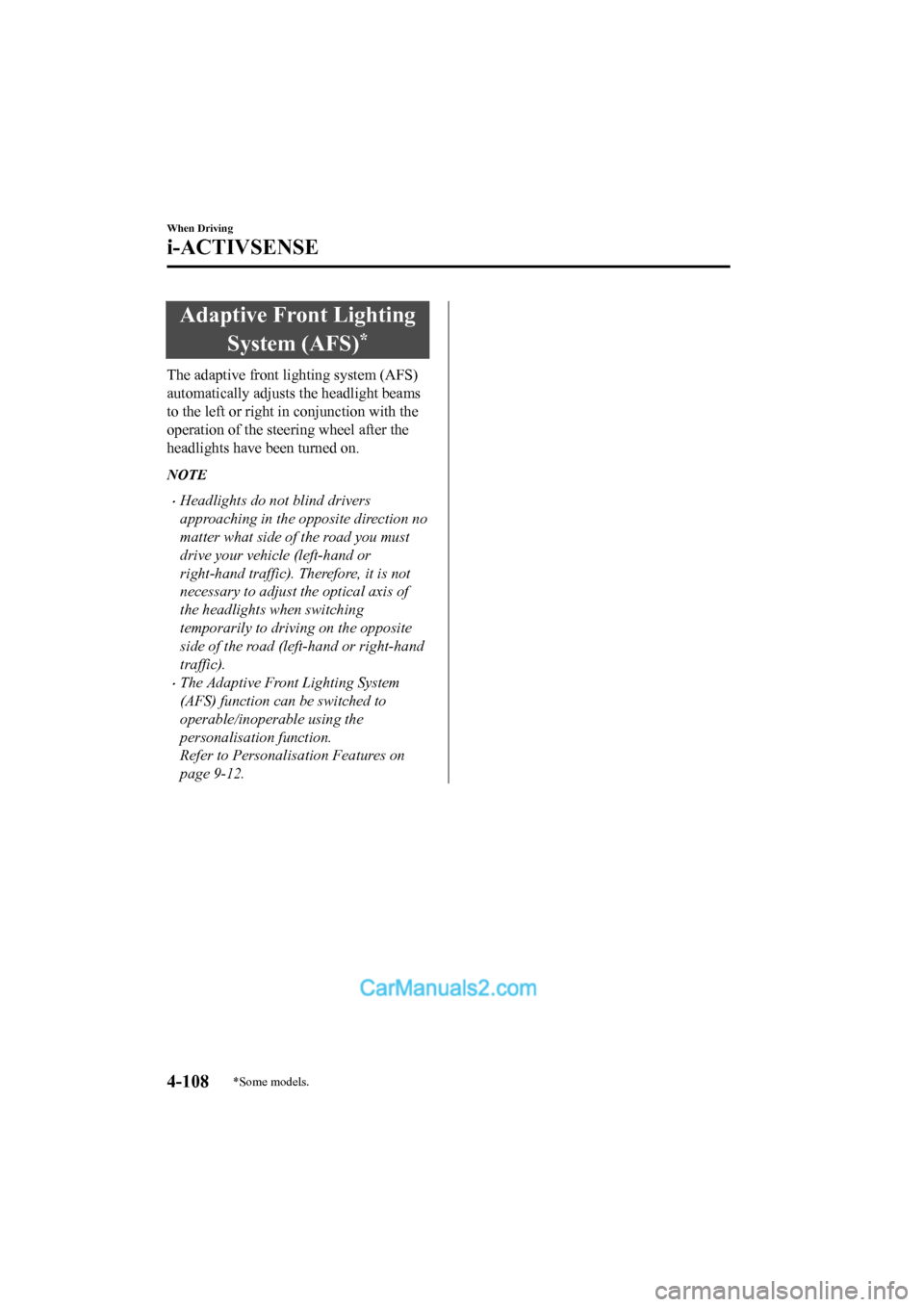
Adaptive Front LightingSystem (AFS)
*
The adaptive front lighting system (AFS)
automatically adjusts the headlight beams
to the left or right i n conjunction with the
operation of the steering wheel after the
headlights have been turned on.
NOTE
•Headlights do not blind drivers
approaching in the opposite direction no
matter what side of the road you must
drive your vehicle (left-hand or
right-hand traffic). Therefore, it is not
necessary to adjust the optical axis of
the headlights when switching
temporarily to driving on the opposite
side of the road (left-hand or right-hand
traffic).
•The Adaptive Front Lighting System
(AFS) function can be switched to
operable/inoperable using the
personalisation function.
Refer to Personalisation Features on
page 9-12.
When Driving
i-ACTIVSENSE
4-108*Some models.
2017-6-7 7:51:19 Form No. CX-5 8FY4-EE-17E+L_Edition2
Page 290 of 772
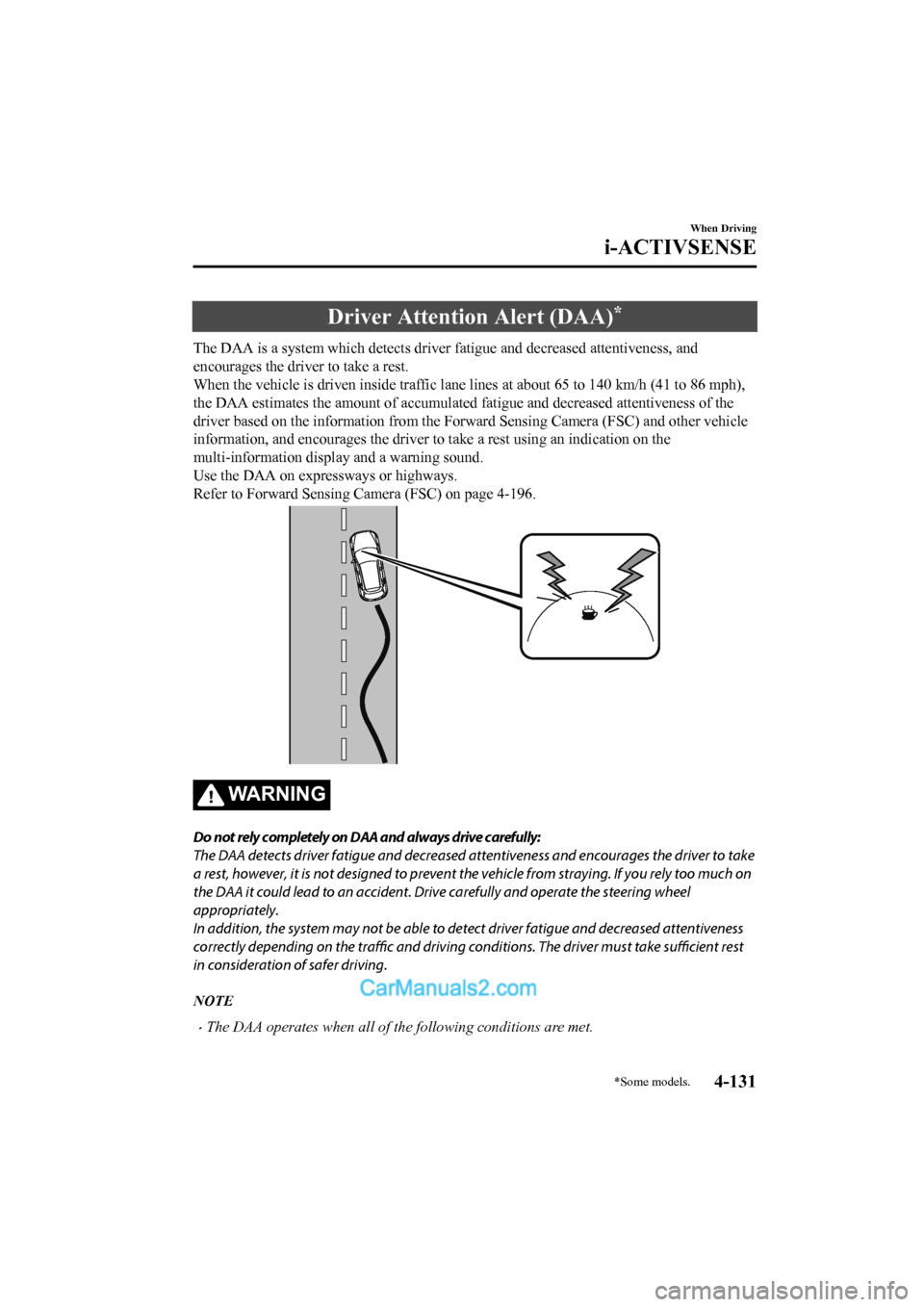
Driver Attention Alert (DAA)*
The DAA is a system which detects driver fatigue and decreased attentiveness, and
encourages the driver to take a rest.
When the vehicle is d riven inside traffic lane lines at about 65 to 140 km/h (41 to 86 mph),
the DAA estimates the amount of accumulated fatigue and decreas ed attentiveness of the
driver based on the information from the Forward Sensing Camera (FSC) and other vehicle
information, and encourages the driver to take a rest using an indication on the
multi-information display and a warning sound.
Use the DAA on expressways or highways.
Refer to Forward Sensing Camera (FSC) on page 4-196.
WA R N I N G
Do not rely completely on DAA and always drive carefully:
The DAA detects driver fatigue and decreased atte ntiveness and encourages the driver to take
a rest, however, it is not designed to prevent the vehicle from straying. If you rely too much on
the DAA it could lead to an accident. Drive carefully and operate the steering wheel
appropriately.
In addition, the system may not be able to detect driver fatigue and decreased attentiveness
correctly depending on the traffic and driving conditions. The driver must take sufficient rest
in consideration of safer driving.
NOTE
•The DAA operates when all of the following conditions are met.
When Driving
i-ACTIVSENSE
*Some models.4-131
2017-6-7 7:51:19 Form No. CX-5 8FY4-EE-17E+L_Edition2
Page 322 of 772
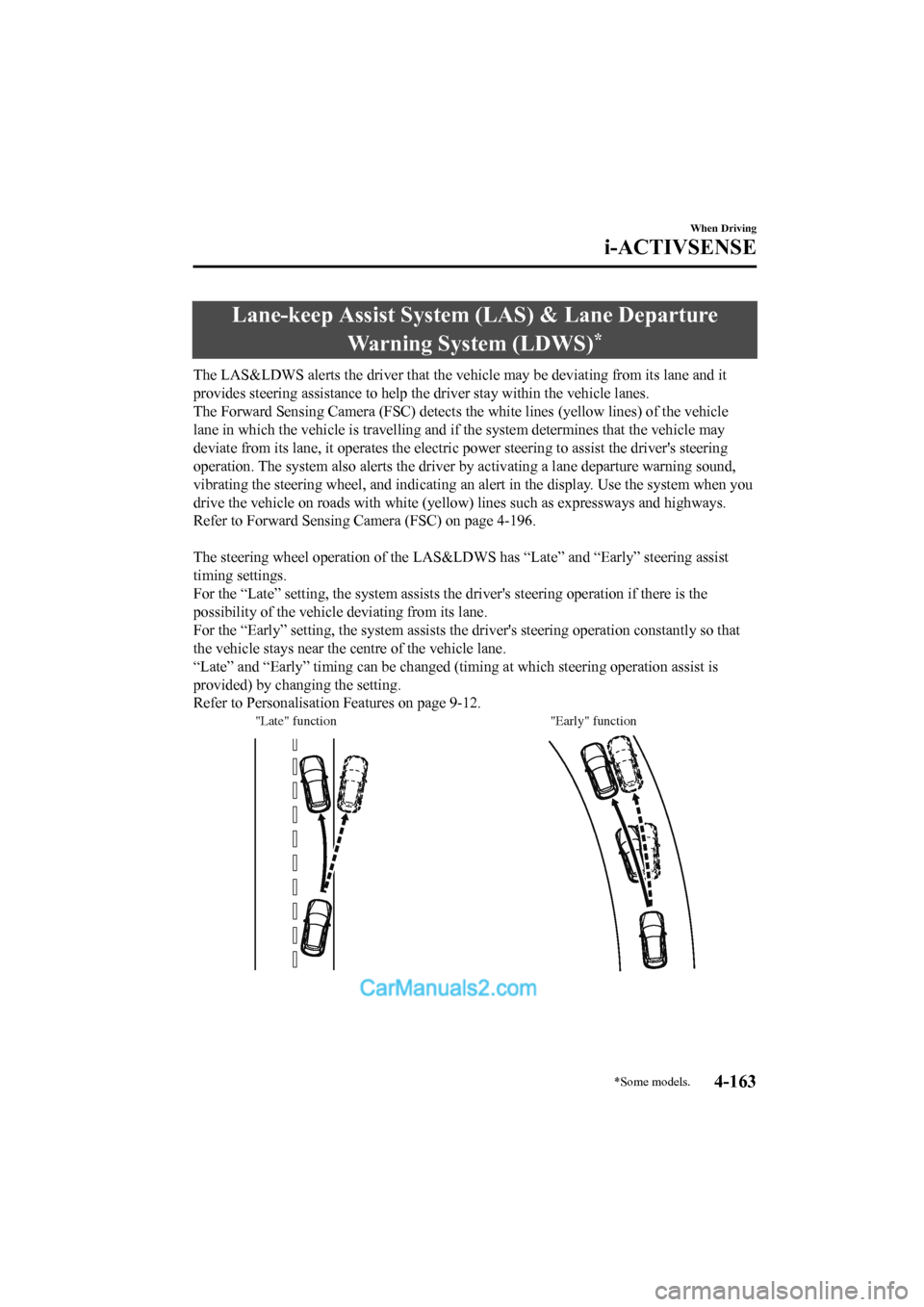
Lane-keep Assist System (LAS) & Lane DepartureWarning System (LDWS)
*
The LAS&LDWS alerts the driver th at the vehicle may be deviating from its lane and it
provides steering assistance to help the driver stay within the vehicle lanes.
The Forward Sensing Camera (FSC) detects the white lines (yello w lines) of the vehicle
lane in which the vehicle is tra velling and if the system determines that the vehicle may
deviate from its lane, it operates the electric power steering to assist the driver's steering
operation. The system also alerts the driver by activating a la ne departure warning sound,
vibrating the steering wheel, and indicating an alert in the di splay. Use the system when you
drive the vehicle on ro ads with white (yellow) lines such as ex pressways and highways.
Refer to Forward Sensing Camera (FSC) on page 4-196.
The steering wheel operation of the LAS&LDWS has “Late” and “Ea rly” steering assist
timing settings.
For the “Late” setting, the system assists the driver's steerin g operation if there is the
possibility of the vehicle deviating from its lane.
For the “Early” setting, the sys tem assists the driver's steering operation constantly so that
the vehicle stays near the centre of the vehicle lane.
“Late” and “Early” timing can b e changed (timing at which steer ing operation assist is
provided) by changing the setting.
Refer to Personalisation Features on page 9-12.
"Late" function "Early" function
When Driving
i-ACTIVSENSE
*Some models.4-163
2017-6-7 7:51:19 Form No. CX-5 8FY4-EE-17E+L_Edition2
Page 323 of 772
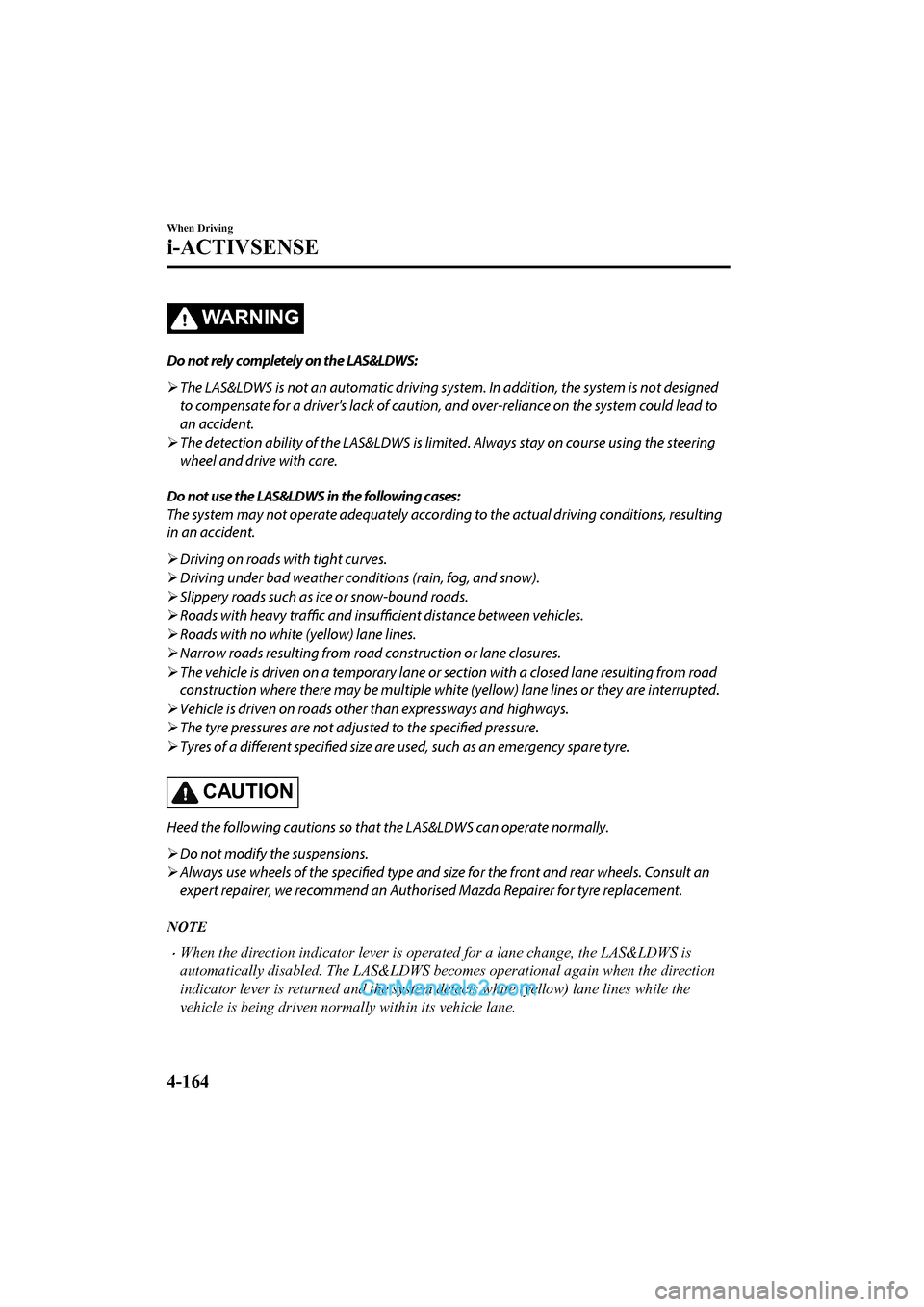
WA R N I N G
Do not rely completely on the LAS&LDWS:
The LAS&LDWS is not an automatic driving system. In addition, the system is not designed
to compensate for a driver's lack of caution, and over-reliance on the system could lead to
an accident.
The detection ability of the LAS&LDWS is limite d. Always stay on course using the steering
wheel and drive with care.
Do not use the LAS&LDWS in the following cases:
The system may not operate adequately accordin g to the actual driving conditions, resulting
in an accident.
Driving on roads with tight curves.
Driving under bad weather conditions (rain, fog, and snow).
Slippery roads such as ice or snow-bound roads.
Roads with heavy traffic and insufficient distance between vehicles.
Roads with no white (yellow) lane lines.
Narrow roads resulting from road construction or lane closures.
The vehicle is driven on a temp orary lane or section with a closed lane resulting from road
construction where there may be multiple white (yellow) lane lines or they are interrupted.
Vehicle is driven on roads other than expressways and highways.
The tyre pressures are not adjusted to the specified pressure.
Tyres of a different specified size are used, such as an emergency spare tyre.
CAUTION
Heed the following cautions so that the LAS&LDWS can operate normally.
Do not modify the suspensions.
Always use wheels of the specified type and size for the front and rear wheels. Consult an
expert repairer, we recommend an Authoris ed Mazda Repairer for tyre replacement.
NOTE
•When the direction indicator lever is operated for a lane change, the LAS&LDWS is
automatically disabled. The LAS&LDWS beco mes operational again when the direction
indicator lever is returned and the system detects white (yellow) lane lines while the
vehicle is being driven normally within its vehicle lane.
When Driving
i-ACTIVSENSE
4-164
2017-6-7 7:51:19 Form No. CX-5 8FY4-EE-17E+L_Edition2
Page 324 of 772
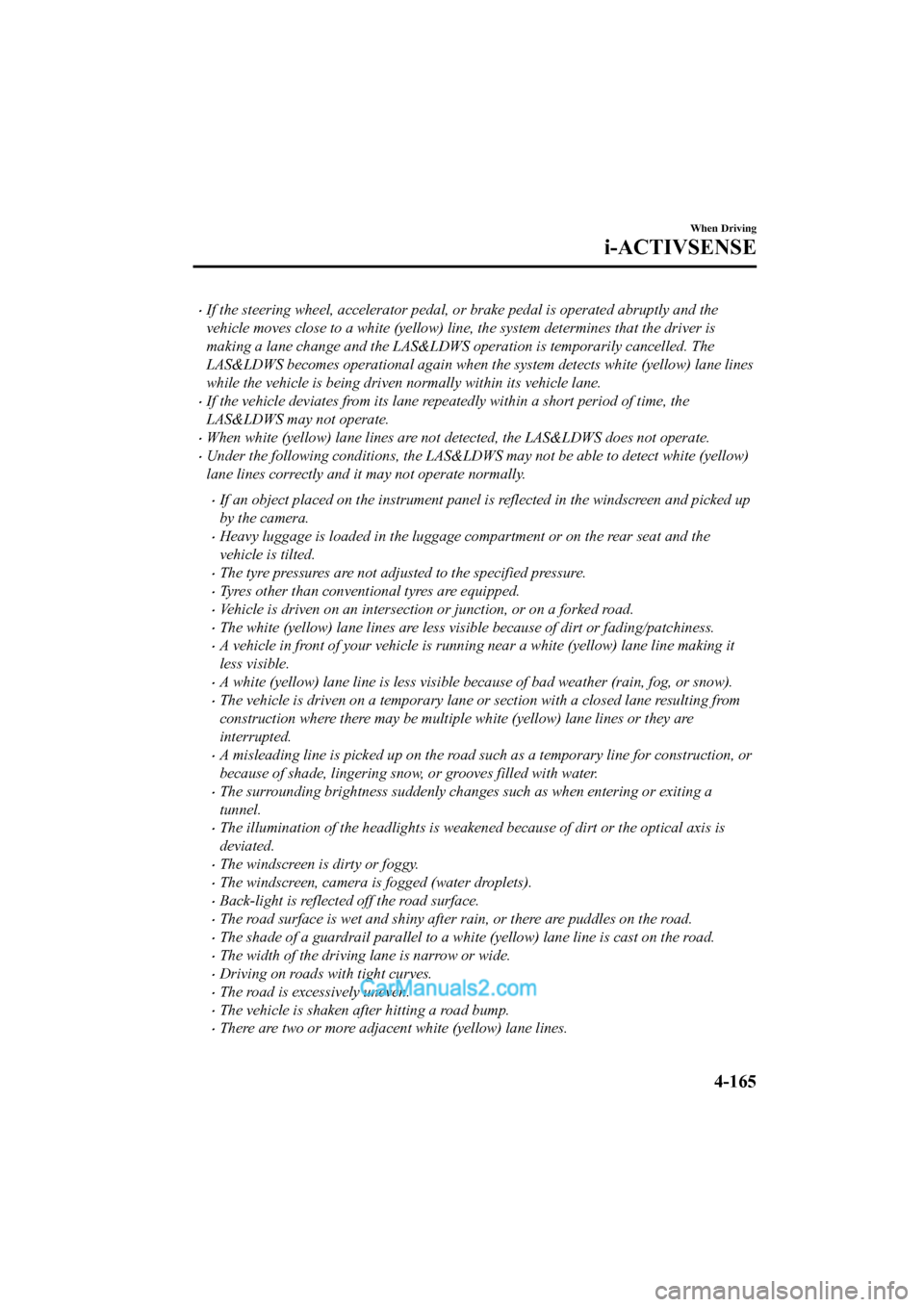
•If the steering wheel, accelerator pedal, or brake pedal is operated abruptly and the
vehicle moves close to a white (yellow) line, the system determines that the driver is
making a lane change and the LAS&LDWS operation is temporarily cancelled. The
LAS&LDWS becomes operational again when the system detects white (yellow) lane lines
while the vehicle is being driven normally within its vehicle lane.
•If the vehicle deviates from its lane repeatedly within a short period of time, the
LAS&LDWS may not operate.
•When white (yellow) lane lines are not detected, the LAS&LDWS does not operate.
•Under the following conditions, the LAS&LDWS may not be able to detect white (yellow)
lane lines correctly and it may not operate normally.
•If an object placed on the instrument panel is reflected in the windscreen and picked up
by the camera.
•Heavy luggage is loaded in the luggage compartment or on the rear seat and the
vehicle is tilted.
•The tyre pressures are not adjusted to the specified pressure.
•Tyres other than conventional tyres are equipped.
•Vehicle is driven on an intersection or junction, or on a forked road.
•The white (yellow) lane lines are less visi ble because of dirt or fading/patchiness.
•A vehicle in front of your vehicle is running near a white (yellow) lane line making it
less visible.
•A white (yellow) lane line is less visible because of bad weather (rain, fog, or snow).
•The vehicle is driven on a temporary lane or section with a closed lane resulting from
construction where there may be multiple wh ite (yellow) lane lines or they are
interrupted.
•A misleading line is picked up on the road su ch as a temporary line for construction, or
because of shade, lingering snow, or grooves filled with water.
•The surrounding brightness suddenly changes such as when entering or exiting a
tunnel.
•The illumination of the headlights is weakened because of dirt or the optical axis is
deviated.
•The windscreen is dirty or foggy.
•The windscreen, camera is fogged (water droplets).
•Back-light is reflected off the road surface.
•The road surface is wet and shiny after rain, or there are puddles on the road.
•The shade of a guardrail parallel to a white (yellow) lane line is cast on the road.
•The width of the driving lane is narrow or wide.
•Driving on roads with tight curves.
•The road is excessively uneven.
•The vehicle is shaken after hitting a road bump.
•There are two or more adjacent white (yellow) lane lines.
When Driving
i-ACTIVSENSE
4-165
2017-6-7 7:51:19 Form No. CX-5 8FY4-EE-17E+L_Edition2